Leadership vs. Management: 6 Key Differences to Know
Leadership and management go hand in hand, and often, we expect managers to be great leaders or for leaders to be great managers.
Management and leadership are distinct skills, however. Not being a natural leader doesn’t preclude someone from being an effective manager, and similarly, someone can be a valuable leader without having the strongest management skills.
Organizations benefit from having a balanced blend of leadership and management. Leaders boost team engagement, encouraging people to strive for excellence, while managers build the processes that guide teams toward success. Together, leadership and management allow companies to build a cohesive, engaged workplace.
Let’s explore the differences between leadership and management, and understand how each contributes to successful projects.
What is leadership?
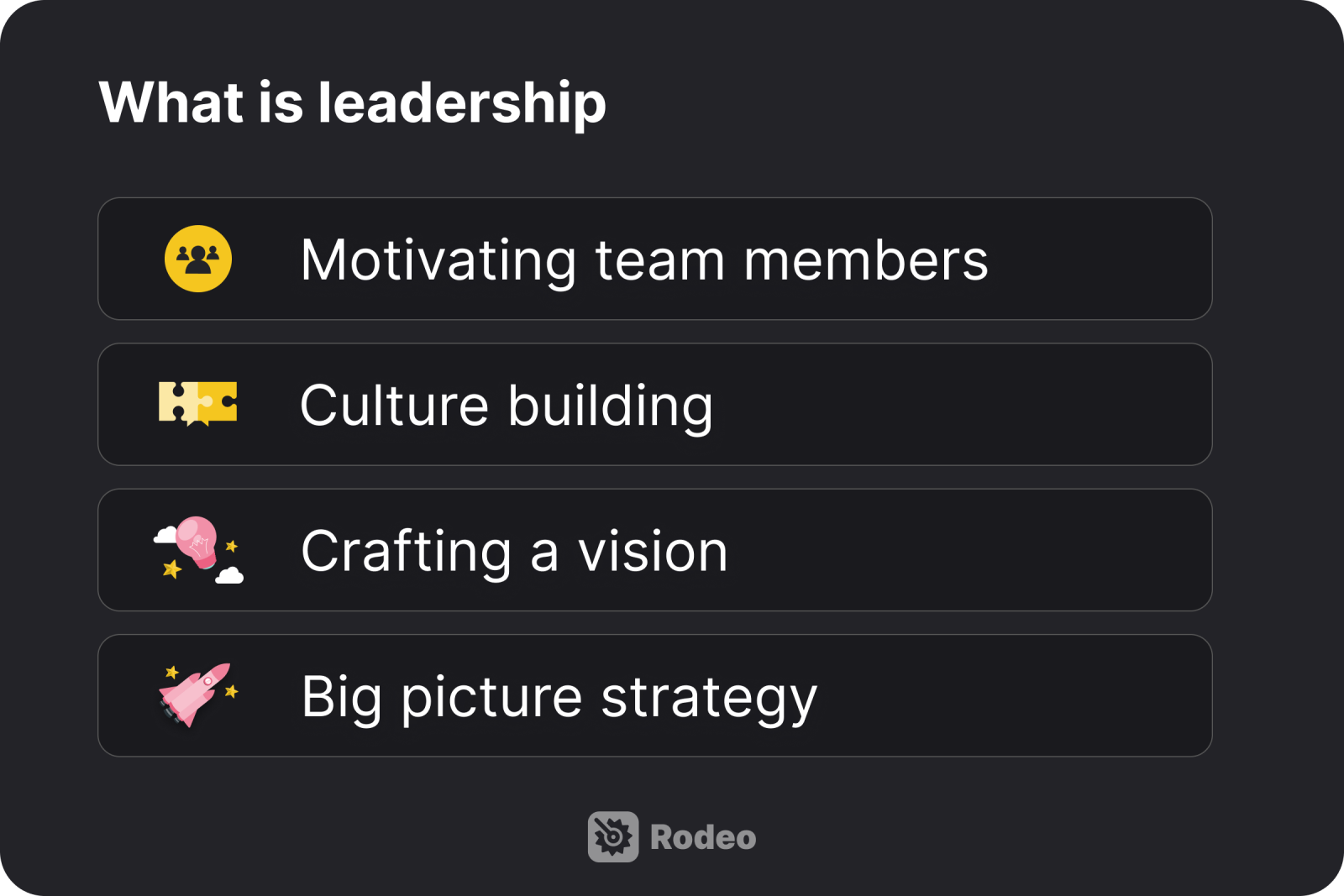
Leadership goes beyond administering tasks. It’s about inspiring and motivating people to perform their best work. Leaders build company culture and communicate a vision that resonates with people, encouraging them to strive toward common goals with enthusiasm and commitment.
Leadership is future-oriented. Leaders use what is called a visionary management style to get employees excited about the company’s direction. They assure team members that despite the challenges they must overcome on the path toward their goals, the destination is worth striving for. Leaders will lean on charisma to inspire the belief that ambitious, seemingly unrealistic goals are achievable.
In essence, leadership is about using people skills to elevate others, bolstering team morale when there are setbacks, fostering a culture of cooperation, and steering an organization toward long-term strategic plans.
What is management?
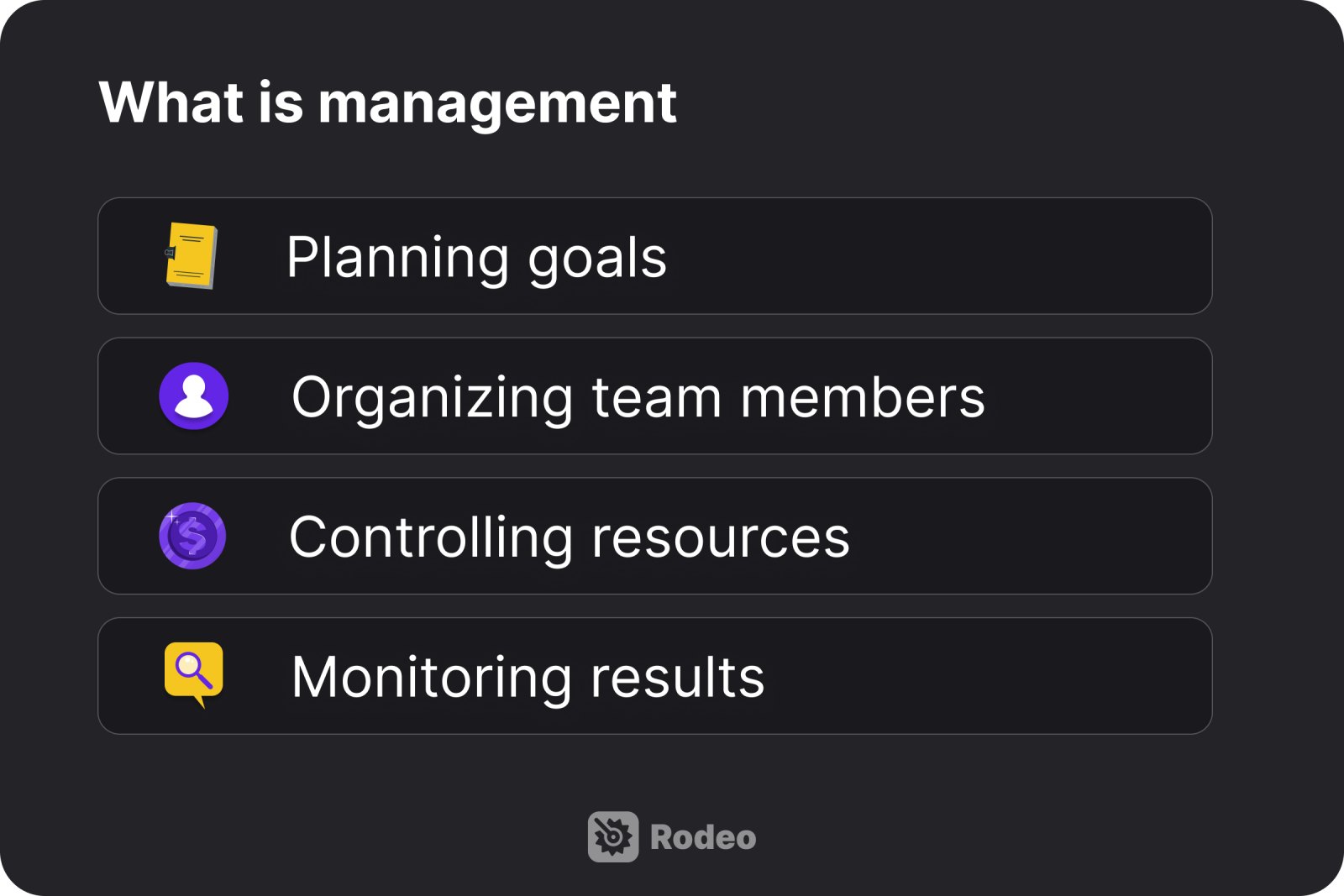
If leadership brings vision to an organization, then management is like a backbone — structuring, stabilizing, and streamlining the path to achieving the big picture.
Management involves planning projects, implementing processes, organizing and directing team members, and controlling resources to efficiently accomplish objectives. They are adept at navigating the complexities of project timelines, milestones, budgets, and resource utilization, ensuring that the team's efforts align with the overarching strategic objectives.
Managers are the architects of processes and systems. They thrive on order, precision, and efficiency. With a keen eye on the present, they orchestrate day-to-day operations with a focus on short-term goals and more immediate outcomes.
Leadership vs. management: 6 main differences
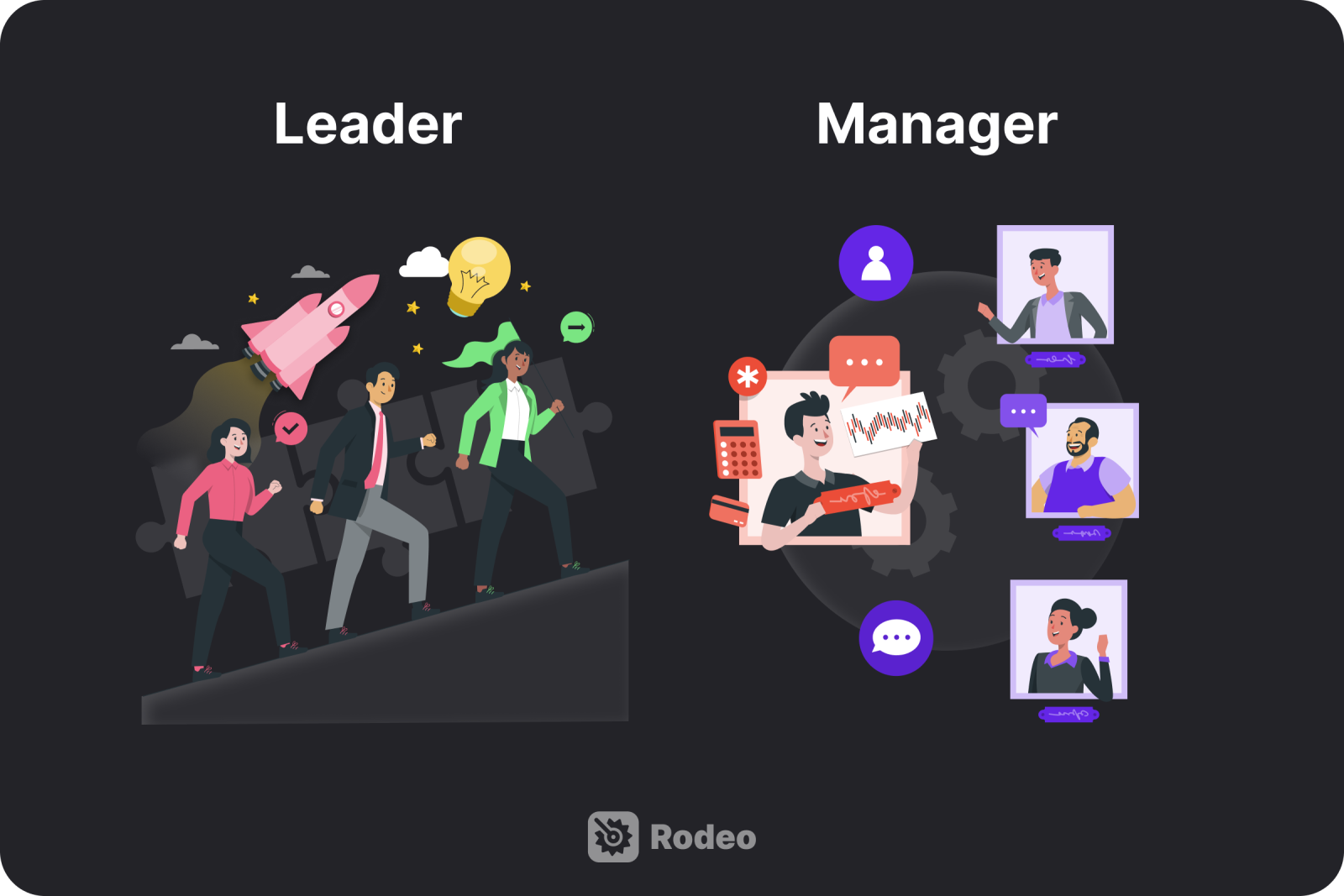
Since leadership and management functions rest with prominent authority figures in a company, it’s easy to see why it’s hard to tell them apart. Leadership and management are indeed complementary functions, and a well-structured organization will have both in equal measure.
But of course, there are differences. To understand what distinguishes them, it helps to look at each of their functions side-by-side.
Vision vs. execution
Leaders are the dreamers, painting the big picture of what could be. They are forward-thinking, and always a step ahead in envisioning future possibilities. Their role is to inspire and set the direction, making sure everyone understands and is aligned with the end goal.
Management, conversely, is grounded in the present, focusing on the mechanics of turning the leader's vision into reality. Managers are pragmatists who take the leader's blueprint and break it down into actionable steps. They chart the course, determine the best methods to achieve the objectives, and oversee the execution, making adjustments as necessary to ensure the project stays on track.
Inspiration vs. coordination
Leaders inspire — they light a fire within people, making them see what they are capable of achieving. Through powerful storytelling and an unwavering belief in their vision, leaders encourage their teams to push beyond their limits and explore possibilities.
Managers, on the other hand, excel in coordination. They are the conductors, ensuring that each team member plays their part at the right time and in harmony with the others. Managers care about optimizing efficiency and hitting measurable objectives.
Change vs. stability
Leaders see change as an opportunity for growth. They prompt their organizations to adapt in response to the environment. They encourage risk-taking, understanding that for an organization to innovate, sometimes its status quo must be challenged.
In contrast, managers seek stability. They prioritize creating order and consistency within teams. Managers will accomplish this by establishing procedures and routines. They provide a sense of predictability so that people can understand their functions and work well. While managers need to be adaptable to change, their primary role is to prevent disruptions and ensure operational effectiveness.
Empowering vs. controlling
Empowerment is a hallmark of effective leadership. Leaders empower people by entrusting them with the authority to make decisions. They aim to foster an environment where team members feel valued and confident in their ability to contribute to the overall success of the organization. Leaders understand employee empowerment leads to engagement and a strong sense of ownership among team members.
Conversely, management often involves a degree of control. Managers ensure teams adhere to established guidelines and meet standards. They monitor performance, provide feedback, and intervene when necessary to correct course.
While good managers understand that control is essential for maintaining structure and ensuring tasks are completed effectively, they balance it with giving team members room to make decisions and grow.
Long-term thinking vs. short-term planning
Leaders focus on long-term goals and the big picture, considering how actions taken today will impact the organization down the line. Leaders are concerned with helping the organization reach its full potential and laying the foundations for sustainable success.
Managers, while aware of the long-term objectives, are more focused on short-term planning. They are concerned with the here and now — what needs to be done today, this week, or this month to keep teams on track. Managers are detail-oriented, specializing in breaking down long-term goals into manageable, immediate tasks.
Relationship-building vs. task-focused
Building strong, meaningful relationships is central to leadership. Leaders invest time and energy in understanding their people — not just their skills and competencies but their aspirations, fears, and motivations. Leaders are also responsible for initiating team-building activities to help their teams become more interconnected.
This relational approach fosters a deep sense of loyalty and commitment, creating a team that is united in its pursuit of the organization's goals.
Good managers prioritize well-being, but because of their operational duties, their primary focus is ensuring tasks are completed effectively. Their approach is concentrated on understanding blockers for team members, supporting good performance, and achieving results.
Leadership vs. management in projects
In the realm of projects, the interplay between leadership and management becomes even more pronounced.
A project without leadership may lack a sense of ‘why,’ struggling to inspire team members to engage with their work fully. Conversely, a project without effective management may flounder in disorganization, failing to meet deadlines and objectives despite the team's enthusiasm.
Successful projects require a vision that motivates the team — a leader's domain. However, they also demand meticulous planning, resource allocation, and execution — areas where managers excel.
Using leadership and management in tandem for successful projects
For projects to reach their full potential, leadership and management need to complement each other. Leaders set the vision for the project, ensuring it aligns with the organization’s strategic objectives. They help maintain the project’s momentum through challenges, keeping the team focused and motivated.
Project managers, on the other hand, translate the established vision into a concrete plan of action. This means outlining the project’s scope, developing schedules, allocating resources, and setting performance metrics. As they handle day-to-day problem-solving and monitor progress, they’ll also make adjustments to keep the project on track.
Both roles are critical to a project's success, especially when those projects are on longer timescales. Leadership provides the perseverance necessary to continue the journey, while management marks the milestones along the path.
Key project management skills
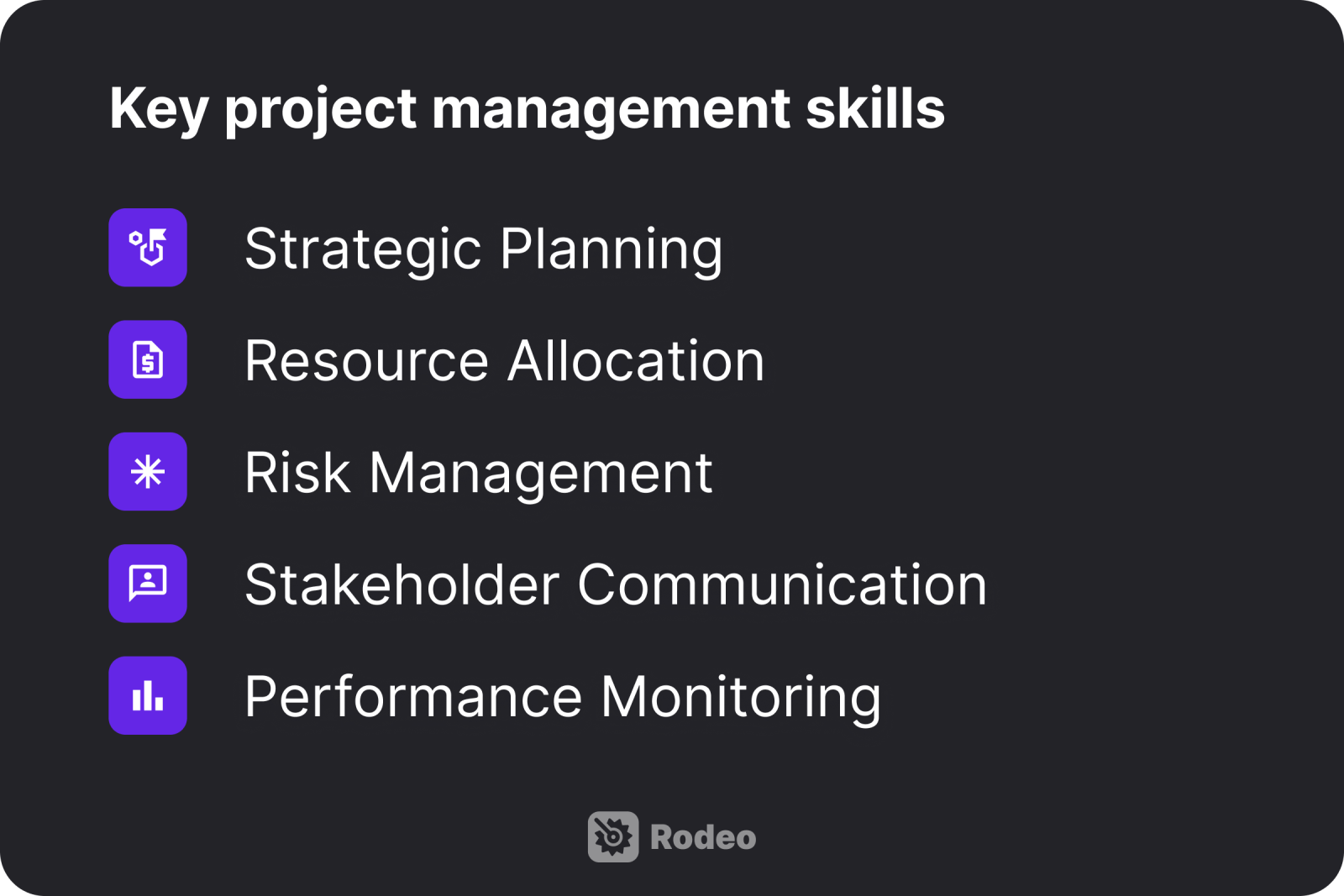
With project management being the cornerstone of successful projects, it makes sense to understand how project management skills differ from project leadership skills. Let’s take a look at what good project managers bring to the table:
Task planning: The ability to see the big picture and align the project with the organization's strategic goals. This involves setting clear objectives, defining the project scope, and developing a plan for how project deliverables will be achieved.
Resource allocation: Efficiently managing resources — be it time, budgets, or personnel — is crucial. This means not only distributing resources where they are needed but also optimizing their use to maximize efficiency and effectiveness.
Risk management: Projects inevitably involve risks. The ability to identify potential risks, assess their impact, and develop strategies to mitigate them is essential for keeping the project on track.
Stakeholder communication: Effective communication management with all stakeholders, from team members to clients and upper management, is key. This involves not only keeping everyone informed about the project's progress but also managing expectations and addressing concerns as they arise.
Performance monitoring: Regularly tracking the project's progress against its goals allows for timely adjustments. This involves setting performance metrics, monitoring outcomes, and implementing corrective actions when necessary.
Key project leadership skills
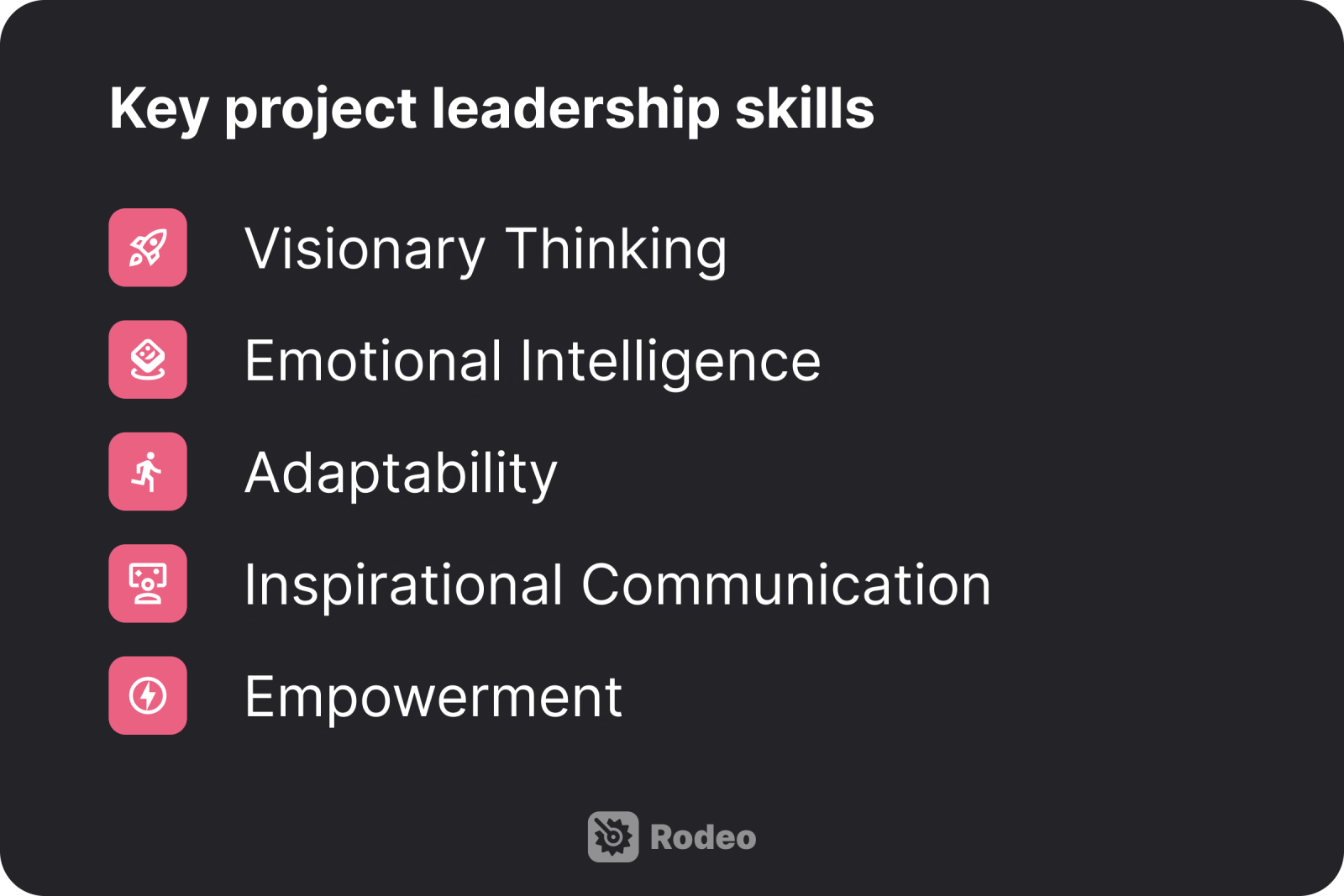
While management skills ensure that projects are executed efficiently, leadership skills are what inspire and drive teams to achieve their best. Here are some essential project leadership skills:
Visionary thinking: Being able to articulate a compelling vision of the future is what sets leaders apart. This involves not just dreaming big but also communicating that vision in a way that inspires others to join in the pursuit.
Emotional intelligence: Understanding and managing one's own emotions, as well as empathizing with others, fostering a positive team environment, and managing workplace issues like burnout.
Adaptability: The ability to adapt to change and lead the team through uncertain times is a hallmark of effective leadership. This means being flexible, open to new ideas, and resilient in the face of setbacks.
Inspirational communication: Beyond just conveying information, leaders must be able to inspire and motivate. This involves speaking to the heart as well as the mind, encouraging the team to embrace challenges and strive for excellence.
Empowerment: Empowering team members by trusting them with responsibilities and the authority to make decisions fosters a sense of ownership and engagement. Leaders understand that empowerment leads to innovation and high performance.
Is leadership or management more important?
The debate over whether leadership or management is more important is a bit of a false dichotomy. Both are essential for the success of any organization or project. Effective leadership without efficient management can lead to a lack of direction and disorganization, while efficient management without effective leadership can result in a lack of motivation and engagement.
The key is to strike the right balance between the two. Organizations need visionary leaders to inspire and guide, as well as skilled managers to plan and execute. In project settings, this balance is even more critical. Projects require a clear vision and direction, as well as meticulous planning and execution.
How to develop better leadership and management skills
Developing both leadership and management skills is a continuous journey. Here are some strategies to enhance these skills:
- Seek mentorship: Learning from those who have successfully navigated the challenges of leadership and management can provide valuable insights and guidance.
- Continuous education: Participating in workshops, courses, and seminars can help you stay up-to-date with the latest trends and techniques in leadership and management.
- Practical experience: Taking on leadership and management roles, even in small projects, can provide hands-on experience and help develop these skills.
- Feedback loops: Regularly seeking feedback from peers, mentors, and team members can provide insights into your strengths and areas for improvement.
- Reflective practice: Taking time to reflect on your experiences, both successes and failures, can help you understand what works, what doesn't, and how you can improve.
Enhance your project management with Rodeo Drive
We’ve discussed the key differences between leadership and management. The most important thing to remember is that both bring value to an organization, and both are worth fostering. Admittedly, we’re partial to the management side of the equation.
Rodeo Drive is a project management platform built to help managers plan activities, track time-spending, and oversee project budgets. It’s a practical tool that helps creative agencies turn visionary ideas into tangible results. Here’s what Rodeo Drive offers:
Intuitive project management
The platform simplifies the project management process by providing a seamless, all-in-one environment where every feature is designed to enhance efficiency and productivity.
At the forefront of Rodeo Drive's offering is its real-time budget monitoring, a feature that marries project activities with financial oversight.
As project activities are planned and executed, your budget will automatically update to reflect real-time financial data. This ensures that project managers are always equipped with the most current financial information, enabling informed decision-making and financial planning without the need for constant manual updates.

Budget metrics in Rodeo Drive allow you to track your team’s spending as you go
Rodeo Drive’s timeline-view planner enhances visibility over resources and project phases. The planner offers a comprehensive view of all ongoing projects, but if you need to manage the details, it also allows you to filter down to individual projects.
You can use the planner to assign activities and plan how hours will be used, ensuring every project activity is budgeted for without overwhelming your capacity.

Manage your project timelines efficiently using Rodeo Drive’s planner
Live time tracking
It can be tricky to get your team members to properly track their time. That’s why Rodeo Drive enables users to track their time in two ways — either by starting their stopwatch when they begin working on a task or by adding a timecard after the fact.
Either way, the value of your team’s time will be automatically reflected in the project budget as they log their hours. This allows you to quickly identify overspending and make adjustments to your project plans immediately.

Live time-tracking in Rodeo Drive makes it easy to track your team’s billable hours
Centralized financial management
Rodeo Drive centralizes the management of expenses, purchase orders, and invoices, making it easier to handle financial documentation and supplier information.
Further, you can ease the financial management of your projects with Rodeo Drive's QuickBooks integration. This feature simplifies the accounting process, allowing for a unified workflow between your project managers and your accountants.
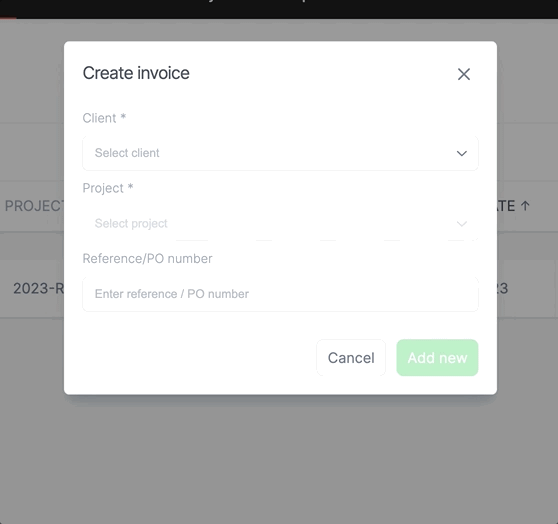
Generate invoices in just a few clicks using Rodeo Drive
Thousands of creative directors, project managers, and consults already use Rodeo Drive to lead their projects with confidence.
You can too. Start using Rodeo Drive for free — no credit card required.







